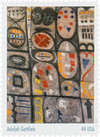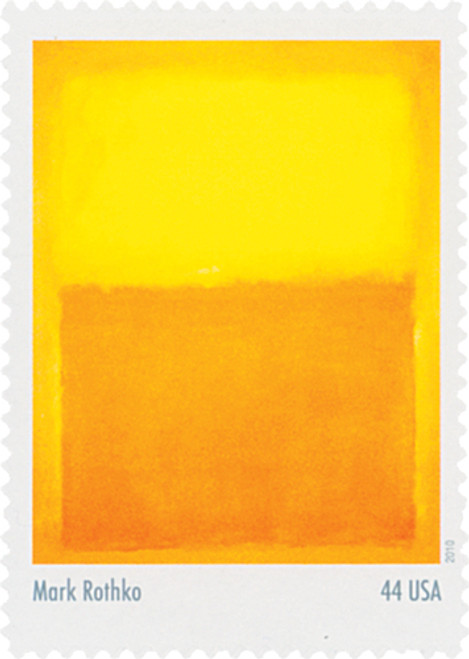
# 4444i - 2010 44c Abstract Expressionist: Adolph Gottlieb
Abstract Expressionists
City: Buffalo, NY
Printing Method: Lithographed
Perforations: Serpentine Die Cut
Birth of Adolph Gottlieb
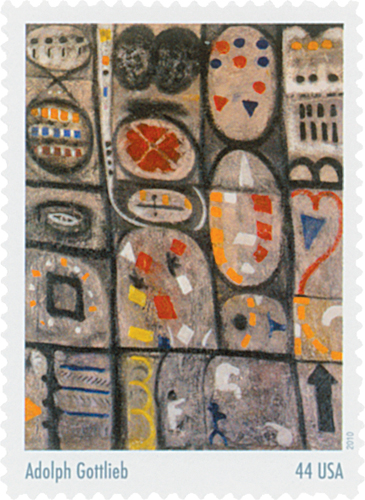
American artist Adolph Gottlieb was born on March 14, 1903, in New York City, New York. Gottlieb’s art was displayed in more than 250 exhibitions during his lifetime, and he’s considered to be one of the first American artists to embrace the Abstract Expressionist movement.
Gottlieb realized his love for art while he was in high school and attended the Art Students League of New York. He then found work on a merchant ship that would take him to Europe to study art there. He spent over a year exploring France, Germany, Austria, and Czechoslovakia, visiting museums in every city he went to. By the time he returned to New York, he was one of the most widely traveled artists in the city at the time. Gottlieb went on to continue his studies at the Art Students League, Parsons School of Design, Cooper Union, and the Educational Alliance.
Gottlieb held his first solo exhibition at New York’s Dudensing Galleries in 1930. In 1935 he joined with a group of other artists known as “The Ten.” The group worked together to promote and sell their work during the tough economic times of the Great Depression.
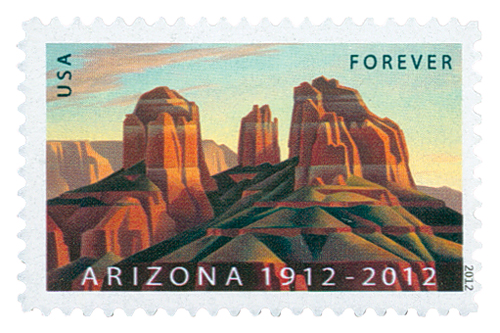
After a brief period of teaching, Gottlieb spent nine months painting in the Arizona desert, which brought about a major change in his work. While he had previously painted in an expressionist-realist style, he began to explore surrealism and formalist abstraction. By the time he returned to New York, many of his artist friends criticized his work for being too abstract. Gottlieb then befriended with European Surrealists who confirmed his belief that the subconscious was the source for universal art.

In the 1940s, Gottlieb began creating what he called “Pictographs.” It was a new form of abstraction that was based entirely on his subconscious, rather than adhering to a determined narrative. He also explored Surrealist bimorphism and automatism, creating organic shapes spontaneously from his subconscious. His style of painting allowed people to interpret his paintings in their own way.
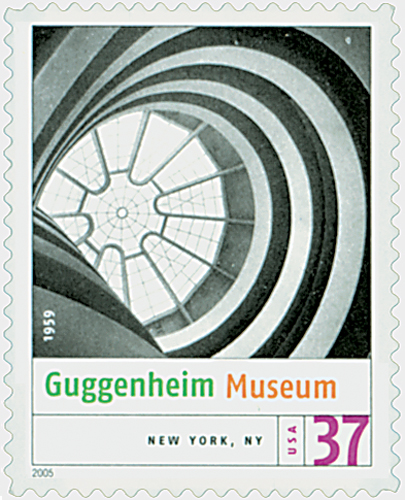
In the 1950s, Gottlieb began to reject the “all-over painting” found in American abstract painting. He began creating large Imaginary Landscapes, with very active lower panels and more passive upper panels, establishing a different style of abstraction. Concerning his work, Gottlieb said, “I frequently hear the question, ”˜What do these images mean?’ This is simply the wrong question. Visual images do not have to conform to either verbal thinking or optical facts. A better question would be ”˜Do these images convey any emotional truth?’”
In the 1960s and 70s Gottlieb embarked his Burst series. These works had simplified disc shapes and winding masses. This work is often considered some of the early color field style, a forerunner of Lyrical Abstraction. In the 1960s, Gottlieb also experimented with sculpture, producing 42 sculptures, including three large outdoor pieces. In 1963 he was the first American artist to earn Brazil’s Gran Premio of the São Paulo Bienale. Additionally, in 1968 the Guggenheim and Whitney Museums in New York held a retrospective exhibition of his art. This was the only collaboration between these two museums to date.

Gottlieb suffered a stroke in 1970 that left him mostly paralyzed except for his right arm and hand. He continued to paint until his death on March 4, 1974. After his death, the Adolph and Esther Gottlieb Foundation was established according to his wishes to provide grants to artists.
Visit the foundation’s website for more on Gottlieb and to view some of his artwork.
Abstract Expressionists
City: Buffalo, NY
Printing Method: Lithographed
Perforations: Serpentine Die Cut
Birth of Adolph Gottlieb

American artist Adolph Gottlieb was born on March 14, 1903, in New York City, New York. Gottlieb’s art was displayed in more than 250 exhibitions during his lifetime, and he’s considered to be one of the first American artists to embrace the Abstract Expressionist movement.
Gottlieb realized his love for art while he was in high school and attended the Art Students League of New York. He then found work on a merchant ship that would take him to Europe to study art there. He spent over a year exploring France, Germany, Austria, and Czechoslovakia, visiting museums in every city he went to. By the time he returned to New York, he was one of the most widely traveled artists in the city at the time. Gottlieb went on to continue his studies at the Art Students League, Parsons School of Design, Cooper Union, and the Educational Alliance.
Gottlieb held his first solo exhibition at New York’s Dudensing Galleries in 1930. In 1935 he joined with a group of other artists known as “The Ten.” The group worked together to promote and sell their work during the tough economic times of the Great Depression.

After a brief period of teaching, Gottlieb spent nine months painting in the Arizona desert, which brought about a major change in his work. While he had previously painted in an expressionist-realist style, he began to explore surrealism and formalist abstraction. By the time he returned to New York, many of his artist friends criticized his work for being too abstract. Gottlieb then befriended with European Surrealists who confirmed his belief that the subconscious was the source for universal art.

In the 1940s, Gottlieb began creating what he called “Pictographs.” It was a new form of abstraction that was based entirely on his subconscious, rather than adhering to a determined narrative. He also explored Surrealist bimorphism and automatism, creating organic shapes spontaneously from his subconscious. His style of painting allowed people to interpret his paintings in their own way.

In the 1950s, Gottlieb began to reject the “all-over painting” found in American abstract painting. He began creating large Imaginary Landscapes, with very active lower panels and more passive upper panels, establishing a different style of abstraction. Concerning his work, Gottlieb said, “I frequently hear the question, ”˜What do these images mean?’ This is simply the wrong question. Visual images do not have to conform to either verbal thinking or optical facts. A better question would be ”˜Do these images convey any emotional truth?’”
In the 1960s and 70s Gottlieb embarked his Burst series. These works had simplified disc shapes and winding masses. This work is often considered some of the early color field style, a forerunner of Lyrical Abstraction. In the 1960s, Gottlieb also experimented with sculpture, producing 42 sculptures, including three large outdoor pieces. In 1963 he was the first American artist to earn Brazil’s Gran Premio of the São Paulo Bienale. Additionally, in 1968 the Guggenheim and Whitney Museums in New York held a retrospective exhibition of his art. This was the only collaboration between these two museums to date.

Gottlieb suffered a stroke in 1970 that left him mostly paralyzed except for his right arm and hand. He continued to paint until his death on March 4, 1974. After his death, the Adolph and Esther Gottlieb Foundation was established according to his wishes to provide grants to artists.
Visit the foundation’s website for more on Gottlieb and to view some of his artwork.




